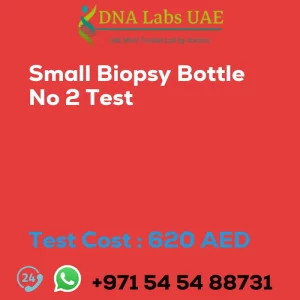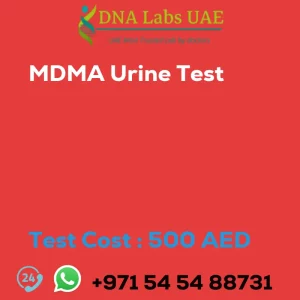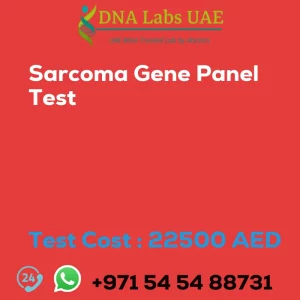ANTENATAL PANEL 1 Test – DNA Labs UAE
Test Name: ANTENATAL PANEL 1 Test
Test Components:
- CBC
- Blood Group + Rh Factor
- Urine R/E
- HIV-1 & 2
- HBsAg
- VDRL
- Glucose F / PP / R
- Hemoglobin electrophoresis
Price: 590.0 AED
Sample Condition:
- 6 mL (3 mL min.) whole blood in 2 Lavender Top (EDTA) tubes
- 2 mL (1 mL min.) plasma from 1 Grey Top (Sodium Fluoride) tube
- 3 mL (1.5 mL min.) serum from 1 SST
- 10 mL (5 mL min.) aliquot of random urine
Ship refrigerated. DO NOT FREEZE.
Duly filled Consent form for HIV testing & Pre-test counselling (Form 10 & 10A) is mandatory.
Report Delivery: Sample Daily by 9 am; Report Next day
Method: Electrical Impedence, VCS, EMT, Dipstick, CMIA, Flocculation, Hexokinase, HPLC
Test Type: Health Check Up
Doctor: Gynecologist
Test Department: Pre Test Information
Duly filled Consent form for HIV testing & Pre-test counselling (Form 10 & 10A) is mandatory.
Test Details
The Antenatal Panel 1 test is a prenatal screening test that is done during the first trimester of pregnancy. It is a blood test that helps to assess the risk of certain genetic conditions in the fetus. The test typically includes the following components:
- Maternal age: The mother’s age is an important factor in determining the risk of certain genetic conditions, such as Down syndrome. The test takes into account the mother’s age at the time of conception.
- Nuchal translucency ultrasound: This is an ultrasound scan that measures the thickness of the fluid at the back of the baby’s neck. An increased thickness can indicate an increased risk of chromosomal abnormalities.
- Pregnancy-associated plasma protein-A (PAPP-A): This is a protein produced by the placenta during pregnancy. Abnormal levels of PAPP-A can be associated with an increased risk of certain genetic conditions.
- Human chorionic gonadotropin (hCG): This is a hormone produced by the placenta. Abnormal levels of hCG can be associated with an increased risk of certain genetic conditions.
- Inhibin A: This is a hormone produced by the placenta. Abnormal levels of inhibin A can be associated with an increased risk of certain genetic conditions.
The results of the Antenatal Panel 1 test are used to determine the risk of certain genetic conditions, such as Down syndrome, trisomy 18, and trisomy 13. However, it is important to note that this test is a screening test and not a diagnostic test. If the results indicate an increased risk, further diagnostic tests, such as chorionic villus sampling (CVS) or amniocentesis, may be recommended to confirm the diagnosis. It is important to discuss the results of the Antenatal Panel 1 test with a healthcare provider who can provide appropriate counseling and guidance based on the individual’s specific circumstances.
| Test Name | ANTENATAL PANEL 1 Test |
|---|---|
| Components | *CBC*Blood Group + Rh Factor*Urine R/E *HIV-1 & 2*HBsAg*VDRL *Glucose F / PP / R*Hemoglobin electrophoresis |
| Price | 590.0 AED |
| Sample Condition | 6 mL (3 mL min.) whole blood in 2 Lavender Top (EDTA) tubes AND2 mL (1 mL min.) plasma from 1 Grey Top (Sodium Fluoride) tubeAND3 mL (1.5 mL min.) serum from 1 SST AND10 mL (5 mL min.) aliquot of random urine. Ship refrigerated. DO NOT FREEZE. Duly filled Consent form for HIV testing & Pre-test counselling (Form 10 & 10A)is mandatory. |
| Report Delivery | Sample Dailyby 9 am; Report Next day |
| Method | Electrical Impedence, VCS, EMT, Dipstick, CMIA, Flocculation, Hexokinase, HPLC |
| Test type | Health Check Up |
| Doctor | Gynecologist |
| Test Department: | |
| Pre Test Information | Duly filled Consent form for HIV testing & Pre-test counselling (Form 10 & 10A)is mandatory. |
| Test Details |
The Antenatal Panel 1 test is a prenatal screening test that is done during the first trimester of pregnancy. It is a blood test that helps to assess the risk of certain genetic conditions in the fetus. The test typically includes the following components: 1. Maternal age: The mother’s age is an important factor in determining the risk of certain genetic conditions, such as Down syndrome. The test takes into account the mother’s age at the time of conception. 2. Nuchal translucency ultrasound: This is an ultrasound scan that measures the thickness of the fluid at the back of the baby’s neck. An increased thickness can indicate an increased risk of chromosomal abnormalities. 3. Pregnancy-associated plasma protein-A (PAPP-A): This is a protein produced by the placenta during pregnancy. Abnormal levels of PAPP-A can be associated with an increased risk of certain genetic conditions. 4. Human chorionic gonadotropin (hCG): This is a hormone produced by the placenta. Abnormal levels of hCG can be associated with an increased risk of certain genetic conditions. 5. Inhibin A: This is a hormone produced by the placenta. Abnormal levels of inhibin A can be associated with an increased risk of certain genetic conditions. The results of the Antenatal Panel 1 test are used to determine the risk of certain genetic conditions, such as Down syndrome, trisomy 18, and trisomy 13. However, it is important to note that this test is a screening test and not a diagnostic test. If the results indicate an increased risk, further diagnostic tests, such as chorionic villus sampling (CVS) or amniocentesis, may be recommended to confirm the diagnosis. It is important to discuss the results of the Antenatal Panel 1 test with a healthcare provider who can provide appropriate counseling and guidance based on the individual’s specific circumstances. |








